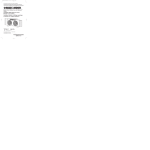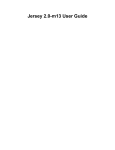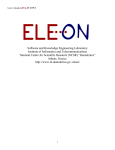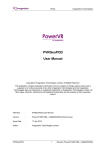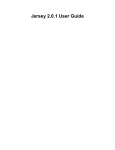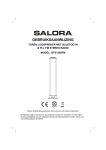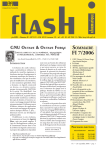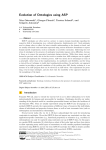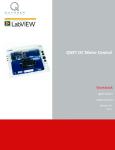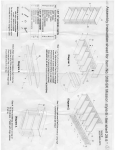Download The RQL v1.5 User Manual
Transcript
The IST Programme Key Action 3 Action Line IST-2000-3.1.4 Contract number IST-2000-26074 Deliverable D3.2.1 The RQL v1.5 User Manual Version: Date: Authors: Contributors: Distribution: v1.5 14 Feb 2002 Grigoris Karvounarakis, Vassilis Christophides (ICS-FORTH) Dimitris Plexousakis, Soa Alexaki (ICS-FORTH) PUBLIC 1 The RQL v1.5 User Manual Grigoris Karvounarakis, Vassilis Christophides Institute of Computer Science, FORTH, Vassilika Vouton, P.O.Box 1385, GR 711 10, Heraklion, Greece fgregkar, [email protected] February 14, 2002 Abstract This document is a tutorial for the RDF Query Language (RQL). RQL is a typed language, following a functional approach, that is dened by a set of basic queries and iterators. This tutorial presents examples of basic meta-schema, schema and data queries, as well as select-from-where lters (iterators) containing generalized path expressions and shows how such queries can be nested to form more complex queries. 1 Introduction This document is a tutorial for the RDF Query Language (RQL). RQL is a typed language, following a functional approach (a la OQL 2]). It is dened by a set of basic queries and iterators. These basic queries are the building blocks of the query language, and will be the rst to be presented. Then, such queries and iterators can be used to build more complex queries through functional composition, by preserving type integrity constraints which are specic for each operation, allowing arbitrary nesting in a query. RQL supports generalized path expressions 3, 4, 1] featuring variables on labels for both nodes (i.e., classes) and edges (i.e., properties), which will also be illustrated through examples and provide the basis for more complex queries. 2 Figure 1: An example of RDF schemas and resource descriptions for a Cultural Portal In this manual we are going to illustrate the use of RQL through queries of increasing complexity, also separating them according to dierent use cases that they satisfy. As a running example for the RQL queries we will use a Cultural Portal, containing descriptions about resources such as Museum Web sites or Web pages with exhibited artifacts, both from a Portal administrator and a museum specialist perspective (i.e. described according to the corresponding RDF schemas). Figure 1 depicts both the employed schemas (upper part) and the RDF descriptions (lower part) contained in this example description base. The upper part of this gure consists of the default RDFS meta-schema classes, i.e., 3 Class and Property, as well as user-dened metaclasses, specializing them (i.e., RealWorldObject, WebResource and SchemaProperty. Moreover, it contains two meta-schema properties, namely related, whihc connects classes, and maxCardinality, which is dened on properties and has an integer value. The middle part consists of two schemas, intended for museum specialists and Portal administrators, respectively. Class denitions in the former respresent RealWorldObjects while the latter instantiates the metaclass WebResource. The lower part depicts superimposed resource descriptions created for several Museum Web sites and artifacts available on the Web, according to these schemas. 2 Schema Querying 2.1 Basic Schema Queries In order to traverse class/property hierarchies dened in a schema, RQL provides functions such as subClassOf (for transitive subclasses) and subClassOf^ (for direct subclasses). For example, we can issue the queries: Q2.1.1 subClassOf(Artist) subClassOf^(Artist) to nd all transitive (direct) subclasses of class Artist. Similarly, functions superClassOf, superClassOf^ return transitive (direct) superclasses. Similar functions exist for schema properties (i.e., subPropertyOf and subPropertyOf^). For example, we can ask for all transitive (direct) subproperties of creates: Q2.1.2 subPropertyOf(creates) subPropertyOf^(creates) Similarly, functions superPropertyOf, superPropertyOf^ return superproperties. All these functions may also be used with a second integer parameter, in order to return, e.g., subclasses of Artist up to depth 2: Q2.1.3 subClassOf(Artist, 2) 4 Then, for a specic property we can nd its denition by applying the functions domain and range: Q2.1.4 domain(creates) range(creates) Moreover, RQL provides the function namespace, in order to retrieve the namespace prex (i.e. the URL of the schema where it is dened) of any schema name (i.e. class, property, metaclass etc). Note that this function returns only one namespace (and works only if it's parameter corresponds to a uniquely identied name). For example, the query: Q2.1.5 namespace(Artist) works only if there is only one class with name Artist in all schemas that have been loaded. For cases when same names are used in dierent schemas one can use the using namespace clause, in order to resolve such naming conicts explicitly, e.g.: Q2.1.6 namespace(ns:Artist) USING NAMESPACE ns = &http://139.91.183.30:9090/RDF/VRP/Examples/demo/culture.rdf# In Section 8 we are also going to depict how one can nd all namespaces in which, e.g., Artist has been dened. 2.2 Querying the Meta-schema More generally, the whole schema can be queried as normal data using appropriately dened meta-classes. This is the case of the default RDF classes Class and Property. Using these names as basic RQL queries, we will obtain in our example, the names of all the classes and properties illustrated in the middle part of Figure 1: Q2.2.1 Class Property Moreover, we can use other meta-schema names as collection names, to get their contents, e.g.: 5 Q2.2.2 Literal Thesaurus Enumeration In order to also accomodate user-dened metaschemas (e.g., DAML+OIL 5]), we have overloaded functions such as subClassOf, subClassOf^, so that they can also be applied on Metaclasses, e.g.: Q2.2.3 subClassOf(Class) subClassOf(Property) while domain, range may return metaclasses (that may contain classes, properties, thesauri etc for properties dened between such metaclasses): Q2.2.4 domain(related) range(related) In order to be able to retrieve only data properties, that are dened at schema level, illustrated at the middle part of Figure 1, (i.e. relations between resources or attributes of resources), one can use the "special", built-in metaclass DProperty: Q2.2.5 DProperty Finally, user-dened metaclasses (see upper part of Figure 1) can also be used as basic queries to retrieve the schema classes or properties which are their instances, e.g: RealWorldObject SchemaProperty 6 2.3 Class & Property Querying RQL also provides a select-from-where lter in order to iterate over these collections by introducing variables. Given that the whole description base or related schemas can be viewed as a collection of nodes/edges, path expressions can be used in RQL lters for the traversal of RDF graphs at arbitrary depths. A rst use case of such queries is schema browsing or ltering this is especially useful for real-scale applications, which employ large description schemas. For example, we can get both the direct domain and range of a schema property, using the query: Q2.3.1 seq( domain(creates), range(creates) ) In this query we use the sequence constructor operator (seq) to construct a sequence value explicitly. Then, consider, for instance the following query, where given a specic schema property we want to nd all related schema classes: Q2.3.2: Which classes can appear as domain and range of the property creates? SELECT $C1, $C2 FROM {$C1}creates{$C2} In this query we use the prex $ for variable names to denote variables ranging on schema classes (i.e. node labels). The result of this query is shown in Figure 2. A similar query, not including the direct domain and range of property creates is the following: Q2.3.2.1 SELECT X, Y FROM subclassof(domain(creates)){X}, subclassof(range(creates)){Y} A more explicit (but also less ecient) query that is equivalent to Q3.2 is the following: Q2.3.2.2 SELECT X, Y FROM Class{X}, Class{Y}, {X}creates{Y} Since $X denotes class variables, it is equivalent with a scan on Classes (ClassX). Then, we can re-use already dened variables (X, Y), instead of dening new schema variables in the extremeties of creates. This way, we implicitly apply a condition on X and Y: X (Y) should be 7 Figure 2: The result of query Q2.3.2 a subclass of the domain (range) of property creates. Moreover, in order to disambiguate such cases (where we don't use schema variables but we refer to schema operations on the domain and range of properties) from data paths (where we want from- and to-values of a property), we use the symbol '' as a position indicator. This will be more obvious in examples of mixed paths in Section 4, where '' is used to separate data and schema variables, when they both appear at the same end of the path. Similarly, a constant class name can be used instead of an already bound variable, in order to nd only properties that can applied on class Painter: Q2.3.3: Find all properties dened on class Painter and its superclasses (i.e. all properties that can be applied on class Painter) SELECT @P, range(@P) FROM {Painter}@P In this query, @P denotes a property variable, that is implicitly range-restricted on the set of all data properties (i.e. DProperty). Then, the result of Q2.3.3 contains all properties that may be applied on Painters, either because they are directly dened on class Painter or 8 Figure 3: The result of query Q2.3.4 because they are inherited from a superclass of Painter. Thus, an equivalent RQL query is the following: Q2.3.3.1 SELECT P, range(P) FROM DProperty{P} WHERE domain(P) >= Painter In this query, the >= predicate in the WHERE clause denotes class ordering using the subclassof relation, as we will explain later. In order to retrieve only properties that are directly dened on Painter, we simply have to replace the '>=' with '=' in the WHERE clause of Q2.3.3.1. Suppose now that we only want to nd relationships that can be applied on Painter, i.e. only properties with class range, and iterate on their subclasses (i.e., get all possible range classes). For this we can use the following query: Q2.3.4 SELECT @P, $Y FROM {Painter}@P{$Y} The use of a schema variable (with the $ prex) restricts the result to the properties with class range. More specically, it implies the condition: range(@P) in Class. The result of this query is shown in gure 3. 9 Figure 4: The result of query Q2.3.5 In order to also include properties with literal, thesauri, enumeration or metaclass range, we use the prex $$, as in the following query: Q2.3.5 SELECT @P, $$Y FROM {Painter}@P{$$Y} The result of this query is depicted in Figure 4. Similar to the use of class names in path extremeties, as in the above queries, we can also use literal type names, where applicable, e.g., to nd all string-valued properties: Q2.3.6 SELECT @P FROM @P{string} 2.4 Schema Navigation Simple path expressions, as the ones presented in previous queries, can be composed - using the operator '.' - in order to traverse paths in schema graphs. Consider, for example, the 10 following query: Q2.4.1: Find the ranges of the property exhibited that can be reached from a class in the range of property creates SELECT $X, $Z FROM creates{$X}.{$Y}exhibited{$Z} In this query, $X, $Y and $Z iterate over the subclass tree of the range or domain and range of the properties creates and exhibited, respectively. Then, the composition of the two paths using '.' is a shortcut notation, implying the condition $X = $Y. Thus, an equivalent to the above query (without '.') is the following: Q2.4.1.1 SELECT $X, $Z FROM creates{$X}, {$Y}exhibited{$Z} WHERE $X = $Y Since we do not want to retrieve classes at the domain of exhibited, we can omit the $Y from the above query: Q2.4.2 SELECT $X, $Z FROM creates{$X}.exhibited{$Z} The implied condition for this query is slightly dierent instead of computing the subclass tree of the domain of exhibited, we merely require that $X is a subclass of the domain of exhibited: Q2.4.2.1 SELECT $X, $Z FROM creates{$X}, exhibited{$Z} WHERE $X <= domain(exhibited) A similar path expression, returning all properties that can be applied on range classes of property creates is the following: Q2.4.3 SELECT $X, @P, range(@P) FROM creates{$X}.@P Figure 5 summarizes dierent combinations of the composition of two schema path components, having properties or property variables as their elements. 11 C2 Path Expression Variable bindings P2 P1 {$X}. P2 P1 {$X}. P3 P1 {:C 3 }.{$X} P2 P1 {$X}.{: C 3} P2 P1 .@P P1 0000TT 13 1111 1111T 3 0000 1111T 3 0000 1111 0000 : @P0000 1111P2, P3 (T1, P2 ), (T3, P3 ) : ($X, @P) 1111 0000 : @P0000 P3 1111 : (@P, @Q) (P1, P2 ), (P1, P3 ) : $X : $X : $X : $X C1 1111111111111111111111 0000000000000000000000 P1 {$X}. @P 0000000000000000000000 1111111111111111111111 P1 {:C 3 }.@P 0000000000000000000000 1111111111111111111111 0000000000000000000000 1111111111111111111111 @P.@Q 0000000000000000000000 1111111111111111111111 0000000000000000000000 1111111111111111111111 0000000000000000000000 1111111111111111111111 C3 P3 0000000000000000000000 1111111111111111111111 00000000000000000000000000 11111111111111111111111111 0000000000000000000000 1111111111111111111111 00000000000000000000000000 11111111111111111111111111 0000000000000000000000 1111111111111111111111 T1 00000000000000000000000000 11111111111111111111111111 0000000000000000000000 1111111111111111111111 00000000000000000000000000 11111111111111111111111111 0000000000000000000000 1111111111111111111111 00000000000000000000000000 11111111111111111111111111 0000000000000000000000 1111111111111111111111 00000000000000000000000000 11111111111111111111111111 0000000000000000000000 1111111111111111111111 T3 00000000000000000000000000 11111111111111111111111111 0000000000000000000000 1111111111111111111111 00000000000000000000000000 11111111111111111111111111 0000000000000000000000 1111111111111111111111 00000000000000000000000000 11111111111111111111111111 0000000000000000000000 1111111111111111111111 00000000000000000000000000 11111111111111111111111111 0000000000000000000000 1111111111111111111111 00000000000000000000000000 11111111111111111111111111 0000000000000000000000 1111111111111111111111 Figure 5: Summary of RQL Schema Path Expressions 3 Querying Resource Descriptions The core RQL data queries essentially provide the means to access RDF description bases with minimal knowledge of the employed schema(s). 3.1 Basic Data Queries We can access any RDF collection (class or property extents, container values with RDF data or schema information, etc.) by just writing its name. This is the case of RDF classes considered as unary relations: Q3.1.1 Artist An equivalent RQL query, employing a select-from-where lter is the following: Q3.1.1.1 SELECT X FROM Artist{X} It should be stressed that, by default, we consider an extended class (or property) interpretation, that is the union of the set of proper instances of a class with those of all its subclasses. In order to obtain only the proper instances of a class (i.e., only the nodes labeled with the class URI), RQL provides the special operator (\^"). Then to nd only proper instances of class Artist, we can issue the following query: 12 Q3.1.2 ^Artist In our example, the result is the empty bag, since no resource has been directly classied as instance of Artist. Additionally, RQL uses as entry-points to an RDF description base not only the names of classes but also the names of properties, as for example, creates. By considering properties as binary relations, this basic query will return the bag of ordered pairs of resources belonging to the extended interpretation of creates: Q3.1.3 creates An equivalent RQL query, employing a select-from-where lter is the following: Q3.1.3.1 SELECT X, Y FROM {X}creates{Y} Similarly with the example of classes, we can omit pairs of resources that are connected through subproperties of creates, i.e. nd only proper "instances" of creates: Q3.1.4 ^creates 3.2 Filtering Resource Descriptions For data ltering RQL relies on standard Boolean predicates as =, <, > and like (for string pattern matching). All operators can be applied on literal values (i.e., strings, integers, reals, dates) or resource URIs and class/property/metaclass names. For example: Q3.2.1 1 = 1 1 < 2 are conditions between integers. It should be stressed that this also covers comparisons between class or property names, e.g.: Q3.2.2 Painter < Artist 13 This is equivalent to the basic boolean query: Q3.2.2.1 Painter in subclassof(Artist) Disambiguation is performed in each case by examining the type of operands (e.g., literal value vs. URI equality, lexicographical vs. class ordering, etc.). Finally, the second parameter of the operator like is always a wildcard expressions (i.e. a character string that may also contain the special characters *, +, ?, ^ etc).1 The rst parameter may be either a string, thesaurus term or enumeration value or a schema name (class, property etc). For example: Q3.2.3 "foobar" like "foo*" Artist like "Art*" The following are a few example queries illustrating ltering conditions on various data types: Q3.2.4: Find the le size of the resource with URL http://www.artchive.com/rembrandt/abraham.jpg SELECT Y FROM {X}file_size{Y} WHERE X = &http://www.artchive.com/rembrandt/abraham.jpg Q3.2.5: Find the titles of resources whose URL matches "*www.artchive.com*" (i.e. contains the sub-string "www.artchive.com") SELECT X FROM {X}title{Y} WHERE X like "*www.artchive.com*" Q3.2.6: Find resources that where modied after year 2000, and their modication date SELECT X, Y FROM {X}last_modified{Y} WHERE Y >= 2000-01-01 14 Figure 6: The result of query Q3.3.1 Q3.2.7: Find resources whose working hours are at least one of "9-1, 5-8", "9-4", "9-9" (values of enumerated types are treated as strings) SELECT X, Y FROM {X}working_hours{Y} WHERE Y in bag("9-1, 5-8", "9-4", "9-9") Q3.2.8: Find the resources whose location is equal or a narrower term than "FRANCE" in the localization thesaurus (range of property location) SELECT X, Y FROM {X}location{Y} WHERE Y <= "FRANCE" 3.3 Navigating in Description Graphs In a way similar to schema navigation, as presented in Section 2.4, we can compose data path expressions, in order to navigate in description graphs. Consider, e.g., the following query: Q3.3.1: Find the Museum resources and their modication date SELECT X, Y FROM Museum{X}.{Z}last_modified{Y} The result of this query is shown in Figure 6. Note that in this path expression we compose a path component with a class element (Museum) with another with a property element (last modied). Composition of data path expressions is equivalent with a join between the collections of the corresponding path elements (i.e., the extent of Museum and last modied). This join is made explicitly in the following query (equivalent to Q3.3.1): Q3.3.1.1 SELECT X, Y FROM Museum{X}, {Z}last_modified{Y} WHERE X = Z see fnmatch man page at http://www.europe.redhat.com/documentation/man-pages/man3/fnmatch.3.php3 1 15 Figure 7: The result of query Q3.3.3 As should become more clear with this query, the implied join condition does not involve at all any schema relationship between the two paths. Indeed, in this example, last modied is dened on class ExtResource and not on Museum. Still, since there are several resources that are multiply classied under both classes and several of them have a modication date dened, this query returns meaningful results. In Section 4 we are going to illustrate how one can also lter resource desciptions according to schema restrictions. Note that, when using constant class or property names as the path's elements, (e.g., Museum last modied) path components are automatically considered as data paths, if no variables are dened on their extremeties. On the other hand, paths containing property (@P) or class ($X) variables as their elements, are treated as schema paths (i.e. their domain or range is used to infer the implied condition). As a result, the following is a "pure" data path: Q3.3.2: Find the titles of the resources where are exhibited the resources that have been created by a Sculptor SELECT Z FROM Sculptor.creates.exhibited.title{Z} This is equivalent with the following: Q3.3.2.1 SELECT Z FROM Sculptor{A}.{B}creates{C}.{D}exhibited{E}.{F}title{Z} WHERE A = B and C = D and E = F However, this shortcut notation for path compositions does not accomodate tree-like path expressions. In this case, composition conditions have to be expressed explicitly, as in the following query: Q3.3.3: Find the titles of exhibited resources that have been created by a Sculptor, as well as the resources where they are exhibited SELECT Z, W FROM Sculptor.creates{Y}.exhibited{Z}, {V}title{W} WHERE Y = V The result of this query is shown in Figure 7. 16 Figure 8: The result of query Q4.1 For such cases, one can use the facility of re-using already dened variables, as described in Q2.3.2.2, to imply again a join condition: Q3.3.3.1 SELECT Z, W FROM Sculptor.creates{Y}.exhibited{Z}, {Y}title{W} 4 Using Schema to Filter Resource Descriptions Up to now we have seen how we can query and navigate in schemas, as well as how we can query and navigate in description graphs regardless of the underlying schema(s). Still, RQL allows to combine schema and data ltering and navigation, through the use of mixed path expressions. Consider, for example, the following query (in contrast to Q2.3.2 and Q3.1.3.1): Q4.1: Find the Flemish resources that have created Painting resources SELECT X, Y FROM {XFlemish}creates{YPainting} In this query we are using node labels (i.e., class names) in order to restrict the source and target values of a property. More precisely, the implied conditions in this path expression are: (i) Flemish should be a subclass of the domain of creates, (ii) Painting should be a subclass of the range of creates, (iii) X should belong to the extent of Flemish and (iv) Y should belong in the extent of Painting. The result of this query is illustrated in Figure 8. The dierence between mixed paths and, e.g., data paths should be more obvious in the next example. Consider that we want to nd all the Painting resources that have been exhibited as well as the related target resources of type ExtResource. Note that the class ExtResource does not appear in the range of property exhibited. The appropriate query is the following: 17 Figure 9: The result of query Q5.2 Q4.2 SELECT X, Y FROM {XPainting}exhibited{Y}.ExtResource{Z} The join condition between the two paths is obviously inferred as that of a data path composition (i.e. Y = Z). This means that - using the above expression - we do not enforce the range of exhibited to be related with the class ExtResource. If we wanted to pose such a restriction, the query would be similar to Q4.1: Q4.2.1 SELECT X, Y FROM {XPainting}exhibited{YExtResource} Since, ExtResource is not a subclass of the range of property exhibited, this query would produce a warning and return an empty result. 5 Set-based Queries Common set operators (union, intersect, minus) applied to collections of the same type are also supported. For example, the query: Q5.1 Sculpture intersect ExtResource will return a bag with the URIs of all resources which are classied under both Sculpture and ExtResource. Moreover, we can mix collections denoted by schema names with others created by queries: Q5.2 creates minus (SELECT X, Y FROM {X}paints{Y}) The result of this query is illustrated in Figure 9. 18 However, the following query will return a type error since the function range is dened on names of properties and not on names of classes. Q5.3 bag(range(Artist)) union subclassof(Artifact) 6 Other Container Queries RQL also allows the manipulation of RDF container values. More precisely, we can explicitly construct Bags and Sequences using the basic RQL queries bag and seq, as we did in Q3.1. To access a member of a Sequence we can use as usual the operator \ ]" with an appropriate position index. If the specied member element does not exist, the query will return a runtime error. Alternatively, the Boolean operator in can be used for membership test in Bags. For example: Q6.1 seq(domain(creates), range(creates))0] returns the rst element of the sequence, while Q6.2 {\tt 1 in bag(1, 2)} {\tt \&www.culture.net/picasso132 in Painter} are true, since the rst bag contains 1 while the resource www.culture.net/picasso132 belongs to the extent of Painting. 7 Aggregate Functions Last but not least, RQL is equipped with a complete set of aggregate functions (min, max, avg, sum and count). For instance, we can inspect the cardinality of class extents (or of bags) using the count function: Q7.1 count( Painting ) Note that the parameter of aggregate functions may be any query returning a collection of a proper type, as in the following query: 7.2: Find the maximum number of direct subclasses max(SELECT count(subclassof^(C)) FROM Class{C} WHERE C != Resource) 19 8 Namespace Queries For cases when several dierent schemas are used at the same time, RQL provides the operation namespace, returning the namespace prex of its operand, as well as an extra USING NAMESPACE clause, allowing the denition of namespace prex variables, which can then be used inside queries in order to disambiguate cases when the same, e.g., class name appears in several schemas. The following queries depict this kind of functionality: Q8.1: Find all namespaces where class Artist has been dened SELECT namespace(C) FROM Class{C} WHERE C like "Artist" Q8.2: Find the description of resources, excluding desciptions related to classes and properties of namespace ns1 SELECT X, (SELECT $C, FROM FROM (SELECT @P, Y FROM {W $C} @P {Y} WHERE namespace($C) != ns1 and namespace(@P) != ns1) $C {X}) Resource {X} USING NAMESPACE ns1=&http://139.91.183.30:9090/RDF/VRP/Examples/demo/admin.rdf# 9 Nested Queries As we mentioned in the beginning of this tutorial, RQL - being a functional language - allows arbitrary composition of simple queries and iterators, in order to form more complex queries. For example we can nest any RQL functions: Q9.1: Find the subclasses of the range of the property creates subclass(range(creates)) Moreover, RQL allows the introduction of nested queries in any of the select-from-where clauses. The following examples depict this functionality: Q9.2: Find the description of the resource with URI "http://www.museum.es" (i.e., group properties by the class under which the resource is classied) { nesting in the SELECT clause SELECT $C, (SELECT @P, Y FROM {Z $D} @P {Y} WHERE Z = X and $D = $C) FROM $C {X} WHERE X = &http://www.museum.es 20 Figure 10: The result of query Q9.5 Q9.3: Find the subclasses of Artist except subclasses of Sculptor as well as their corresponding direct instances { nesting in the FROM clause SELECT Y, (SELECT Z FROM Y{Z}) FROM Q9.4: ((SELECT $X FROM Artist{$X}) minus (SELECT $X FROM Sculptor{$X})){Y} Find the most recently modied resource { nesting in the WHERE clause SELECT X, Y FROM {X}last_modified{Y} WHERE Y = max( SELECT Z FROM {W}last_modified{Z} ) Finally, the following query involves several nested queries and aggregate functions. Q9.5: Find the classes with the maximun number of properties SELECT C, count(SELECT @P FROM {C}@P) FROM Class{C} WHERE C != Resource and count(SELECT @P FROM {C}@P) = max( SELECT count(SELECT @Q FROM {D}@Q) FROM Class{D} WHERE D != Resource ) The result of this query is depicted in Figure 10. 21 References 1] S. Abiteboul, D. Quass, J. McHugh, J. Widom, and J. Wiener. The Lorel Query Language for Semistructured Data. International Journal on Digital Libraries, 1(1):68{88, April 1997. 2] R.G.G. Cattell, D. Barry, Berler M, J. Eastman, D. Jordan, C. Russell, O Schadow, T. Stanienda, and F. Velez. The Object Database Standard ODMG 3.0. Morgan Kaufmann, January 2000. 3] V. Christophides, S. Abiteboul, S. Cluet, and M. Scholl. From Structured Documents to Novel Query Facilities. In Proc. of ACM SIGMOD Conf. on Management of Data, pages 313{324, Minneapolis, Minnesota, May 1994. 4] V. Christophides, S. Cluet, and G. Moerkotte. Evaluating Queries with Generalized Path Expressions. In Proc. of ACM SIGMOD, pages 413{422, 1996. 5] F. van Harmelen, P. Patel-Schneider, and I. Horrocks. Reference description of the DAML+OIL ontology markup language. http://www.daml.org/2001/03/reference.html, March 2001. 22






















